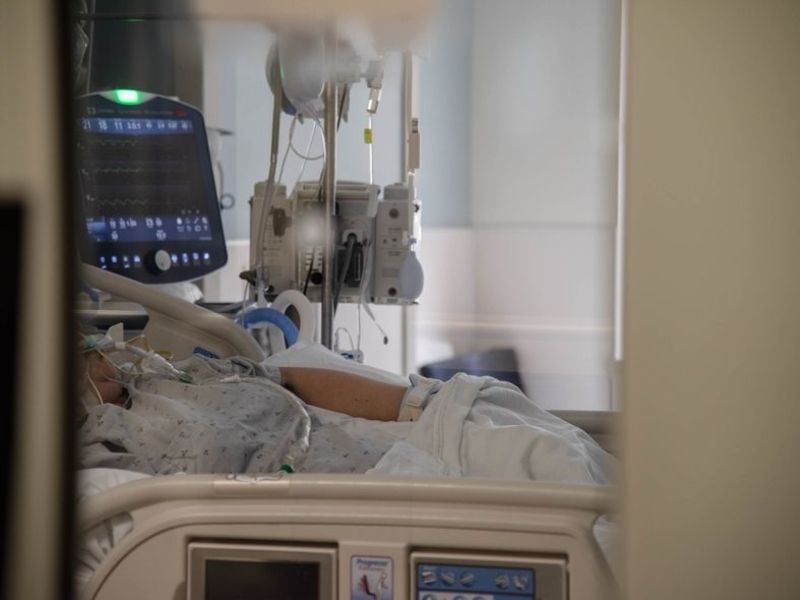 Cydni Elledge for Crain’s Detroit Business Beaumont Health has temporarily closed 180 of its more than 3,000 beds as it lacks adequate staffing to provide patient care in those beds.
Cydni Elledge for Crain’s Detroit Business Beaumont Health has temporarily closed 180 of its more than 3,000 beds as it lacks adequate staffing to provide patient care in those beds.
Beds sit idle at Henry Ford Health System’s five hospitals — most of those empty 120 beds are at its flagship hospital in Detroit and in Jackson.
The patient monitors are off, void of beeps and electrocardiography line art.
Its hospitals aren’t less busy — patients occupy 95 percent of the system’s 2,000 beds. Patients are backing up in emergency rooms waiting for open beds, sometimes as long as six hours.
Melissa Reitz, principal of certificate of need lobbying firm RWC Advocacy, said 80 percent occupancy represents a busy hospital. Above 90 percent is a hospital overwhelmed.
The issue is the health system hasn’t enough staff to man those beds. The entire healthcare sector is facing a longstanding labor shortage that predates COVID-19 but is exacerbated by the latest delta variant surge in the state.
Michigan Medicine temporarily closed 13 beds last week. Currently, about 180 beds at Beaumont Health are closed due to labor shortages, the hospital said in a statement to Crain’s.
Beaumont announced Wednesday that its 10 emergency departments are “experiencing extreme numbers of patients” and are nearly full.
Michigan Medicine did not make an executive available to talk about staffing and Henry Ford declined to further discuss the staffing shortages outside of a media call with reporters this week.
Experts say increasingly difficult working conditions, burnout, a cascade of retirements and an unrelenting pandemic have forced hospital workers out of the industry.
 Christopher Friese
Christopher Friese
“Nurses, in particular, walked into this pandemic in an already strained environment,” said Christopher Friese, professor of nursing, health management and policy at University of Michigan School of Medicine and an active registered nurse. “This isn’t just a leaky bucket, this is an overflowing tub. It’s no surprise hospitals in Michigan and elsewhere are struggling.”
Turbulence before triage
Michigan’s healthcare industry has been on a collision course with labor issues for nearly a decade. Much of it was brought on by demographics and the inevitable glut baby boomer retirements.
Michigan nurses are aging and rapidly. In 2020, nearly 56 percent of registered nurses and 55 percent of licensed practical nurses were over the age of 45, according to a report issued last year by the Michigan Health Institute and the Michigan Department of Health and Human Services. And 35 percent of the state’s nurses have been on the job for more than 20 years.
About 30 percent of all nurses in the state are located in metro Detroit, revealing why retirements are a big problem for area health systems.
Of the 36,617 active licensed registered nurses in the state, 10.2 percent are already retired, according to the state data.
 Charles Ballard
Charles Ballard
Charles Ballard, an economist at Michigan State University, said retirements have spiked during the pandemic as older workers’ fear of COVID-19 and increasingly stressful work pushed many to throw in the towel.
Roughly 2 million more people retired than expected during the pandemic, according to The New School’s Schwartz Center for Economic Policy Analysis.
“We’re seeing people near retirement age who likely would have worked a few more years stepping out of the workforce,” Ballard said. “People are taking time to make real life assessments, asking whether they really like their job or would be happier doing something else or retiring and enjoying the rest of their lives.”
Friese said the deteriorating working environments are forcing the old to retire and the young to explore new careers.
Roughly 22 percent of nurses providing direct patient care said they have interest in leaving their jobs, according to the 2021 McKinsey Future of Work in Nursing Survey. The surveyed nurses indicated increasing demands created both a physical and a psychological strain on the labor force.
Friese said nurses have been forced to care for more and more patients per shift to the point where he believes safety is jeopardized.
“Hospitals are trying to maximize the number of patients a nurse cares for, but we’ve hit a tipping point,” Friese said. “It’s not sustainable for these nurses.”
Friese said general care nurses are caring for as many as eight patients at a time and intensive-care unit nurses are caring for as many as four patients. He said a safe number is 4 general care patients and one or two ICU patients.
“The pandemic exposed the fault lines,” Friese said. “It showed how deep and dangerous this all is. I’m still worried about patients going to the hospital for cancer and heart disease, etc. Can (hospitals) deliver care safely with the number of nurses they have?”
 Adnan Munkarah
Adnan Munkarah
Adnan Munkarah, executive vice president and chief clinical officer at Henry Ford Health, told reporters this week the health system is sacrificing beds instead of patient safety.
“This does not curtail any services,” Munkarah told reporters. “I do worry about the effects of overtime on the staff. We are recruiting and hiring as fast as we can.”
It also remains unclear what impact COVID-19 vaccine mandates are having on the workforce. As of Sept. 13, Henry Ford Health said 98 percent of its roughly 30,000 workers were vaccinated. That leaves as many as 600 unvaccinated and now on unpaid suspension. Representatives from the system declined to discuss how many were nurses or whether workers have quit over the mandate.
It’s also unclear whether mandates will impact hiring.
Looking for an antidote
But hiring remains challenging as workers are quitting or retiring at a rate quicker than education systems can refill the pipeline.
The U.S. Bureau of Labor Statistics estimated about 194,500 new registered nurses are needed annually between 2020 and 2030 to meet demand. But educational institutions only produce about 176,000 nurses of all types in the U.S. each year.
An additional 80,000 qualified nursing school applicants are turned away from programs due to lack of faculty, additional programs or clinical training sites, the Wall Street Journal reported last week.
“We have so many qualified applicants applying to nursing school but we can’t hire enough faculty to train the nurses,” Friese said. “We have to make faculty salary competitive to expand. We’re bursting at the seems with what we can do. We can’t produce more graduates unless we invest in education.”
A proposed bipartisan package of bills in Michigan, the Safe Patient Care Act introduced by Republican Sen. Ed McBroom, would limit the amount of patients are nurse can care for, hopefully alleviating stress on nurses. The package, which remains in committee, would also limit forced overtime for nurses.
“Nurses across the (Upper Peninsula) have told me they simply want to provide the best care possible to every patient, but sometimes they have too many people to take care of to do that,” McBroom said in a press release when the bill was introduced in March.
While the legislation will improve working conditions at hospitals, a lack of transparency between nurses and management remains a large hurdle, Friese said.
“If we stop with just plugging the hole, we are going to miss a huge opportunity,” Friese said. “Nurses are driving the care in hospitals. But the move to corporatized healthcare in the last 10 years, creating these big systems, we’re losing sight of patients and staff. Things are falling through the cracks.”
Friese said administrators need to address worker concerns more thoroughly by commencing listening tours. They also need to redefine nurses’ roles. Friese said nurses are too often bogged down with overly complicated digital health records software, managing documentation for reimbursement and suffering from physical and verbal abuse from patients, patient families and coworkers.
“We really need management and nursing to create a nursing system that meets our needs and the needs moving forward,” Friese said. “Otherwise this problem will only get worse.”
Source link : https://www.modernhealthcare.com/labor/michigans-healthcare-labor-shortage-predates-covid-19-latest-surge-deals-another-critical











